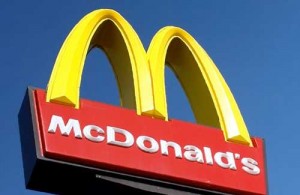22 Dec McDonald’s Finds Loophole To Save Brand Culture
 According to people in San Francisco, CA, McDonald’s Happy Meal toys are responsible for obesity in children. The “enticing toys” are like catnip to children, turning them in ravenous beasts who overpower their adult parents – forcing them to drive the maniacal beasts their children have become to the neighborhood McDonald’s where they eat bad food just to get the tiny, plastic, made-in-China, toy. So in a grand gesture, the city of San Francisco slayed the evil McDonald’s beast by banning the toy give-aways.
According to people in San Francisco, CA, McDonald’s Happy Meal toys are responsible for obesity in children. The “enticing toys” are like catnip to children, turning them in ravenous beasts who overpower their adult parents – forcing them to drive the maniacal beasts their children have become to the neighborhood McDonald’s where they eat bad food just to get the tiny, plastic, made-in-China, toy. So in a grand gesture, the city of San Francisco slayed the evil McDonald’s beast by banning the toy give-aways.
McDonald’s, however, has found a loophole to continue practicing an essential piece of their brand culture.
McDonald’s has announced that they will sell Happy Meal toys in the San Francisco area individually for a measly 10 cents (and donate that 10 cents to charity) instead of giving them away with a Happy Meal purchase; allowing them to still bring joy and happiness to the children (whose parents are willing to pay) and save an important aspect of their brand culture.
The History of the Happy Meal
The Happy Meal originated in 1977 with Dick Brams, McDonald’s St. Louis regional advertising manager, who came up with the idea to make a meal just for kids. In 1979, the Happy Meal became a reality in a circus-wagon-themed box with a hamburger/cheeseburger, french fries, cookies, soft drink, and a toy. The toys back then were simpler; either a McDoodler stencil, McWrist wallet, an ID bracelet, puzzle lock, spinning top, or McDonaldland-character eraser.
By 1987, McDonald’s had made an agreement with Disney and the first Disney Happy Meal made its debut. Ten years later, the Happy Meal toy made history when McDonald’s released Teenie Beanies – miniature versions of the red-hot popular toy, Beanie Babies – by selling more than 100 million of them.
Through the 80’s and 90’s, McDonald’s ramped up their television advertising to include kid-friendly Happy Meal advertisements which announced the latest toy available. McDonald’s was a family hangout, and the place where all the kids wanted to go. The kid-friendly image became an integral part of the culture, and helped lead McDonald’s to great success.
My Thoughts
For people like me, there’s a lot of nostalgia with the Happy Meal toys. Growing up in the 90’s, it was often a Friday night treat to go to McDonald’s before getting groceries, or getting a Happy Meal in exchange for a good report card.
Today’s ever-moving and busy culture has changed, though. Fast food is seen as a quick meal, instead of a treat that one gets every so often. It’s not unusual for people to eat fast food multiple days and nights of any given week. Parents often go through the drive-thru on their way home from work to avoid having to take the time to prepare a proper meal or give in to kid’s whining because it’s easier.
What are your thoughts? Happy Meal memories? Is there a box of old Happy Meal toys in your parents’ basement? Let us know with a comment!




Sorry, the comment form is closed at this time.